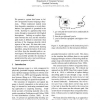Free Online Productivity Tools
i2Speak
i2Symbol
i2OCR
iTex2Img
iWeb2Print
iWeb2Shot
i2Type
iPdf2Split
iPdf2Merge
i2Bopomofo
i2Arabic
i2Style
i2Image
i2PDF
iLatex2Rtf
Sci2ools
ACL
2010
2010
Learning to Follow Navigational Directions
We present a system that learns to follow navigational natural language directions. Where traditional models learn from linguistic annotation or word distributions, our approach is grounded in the world, learning by apprenticeship from routes through a map paired with English descriptions. Lacking an explicit alignment between the text and the reference path makes it difficult to determine what portions of the language describe which aspects of the route. We learn this correspondence with a reinforcement learning algorithm, using the deviation of the route we follow from the intended path as a reward signal. We demonstrate that our system successfully grounds the meaning of spatial terms like above and south into geometric properties of paths.
ACL 2010 | Computational Linguistics | Explicit Alignment | Linguistic Annotation | Navigational Natural Language |
| Added | 10 Feb 2011 |
| Updated | 10 Feb 2011 |
| Type | Journal |
| Year | 2010 |
| Where | ACL |
| Authors | Adam Vogel, Daniel Jurafsky |
Comments (0)

